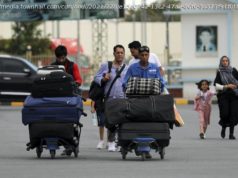Who names hurricanes? Why is it called Hurricane Harvey? Learn more about how hurricanes get their names.
Loving Heavy? Follow us on Facebook!
Hurricane Harvey was gathering steam off the coast of Texas, but how did the storm get its name?
Who thought Harvey was a good name for a weather system? The hurricane could pack quite a punch. “Harvey has rapidly intensified into the third hurricane of the 2017 Atlantic hurricane season and may become the nation’s first Category 3 landfall in almost 12 years, poised to hammer the Texas Gulf Coast with an extremely dangerous combination of torrential rainfall, storm-surge flooding and destructive winds this weekend, before taking a strange, meandering path next week, ” Weather.com reported on August 24,2017.
The World Meteorological Association names hurricanes. According to the National Ocean Service, “Over time, it was learned that the use of short, easily remembered names in written as well as spoken communications is quicker and reduces confusion when two or more tropical storms occur at the same time. In the past, confusion and false rumors resulted when storm advisories broadcast from radio stations were mistaken for warnings concerning an entirely different storm located hundreds of miles away.”
There are six lists of hurricane names. “The six lists… are used in rotation and re-cycled every six years, i.e., the 2017 list will be used again in 2023, ” reports the National Ocean Service. You can read them here. Harvey appears as number 8 on the list for 2017.
The names for 2017 for “Caribbean Sea, Gulf of Mexico and the North Atlantic” are:
Arlene
Bret
Cindy
Don
Emily
Franklin
Gert
Harvey
Irma
Jose
Katia
Lee
Maria
Nate
Ophelia
Philippe
Rina
Sean
Tammy
Vince
Whitney
There are other lists of names for different areas of the world. The WMA explains, “Hurricane, cyclone and typhoon are different terms for the same weather phenomenon which is accompanied by torrential rain and maximum sustained wind speeds (near centre) exceeding 119 kilometers per hour.”
The WMA explains, “In the beginning, storms were named arbitrarily. An Atlantic storm that ripped off the mast of a boat named Antje became known as Antje’s hurricane. Then the mid-1900’s saw the start of the practice of using feminine names for storms. In the pursuit of a more organized and efficient naming system, meteorologists later decided to identify storms using names from a list arranged alpabetically. Thus, a storm with a name which begins with A, like Anne, would be the first storm to occur in the year. Before the end of the 1900’s, forecasters started using male names for those forming in the Southern Hemisphere.”
The lists originate with the National Hurricane Center but are maintained by WMA.
The National Ocean Service reports that, in 1953, the United States “began using female names for storms and, by 1978, both male and female names were used to identify Northern Pacific storms. This was then adopted in 1979 for storms in the Atlantic basin.”
NOAA’s National Hurricane Center does not control the naming of tropical storms, according to the National Ocean Service. “Instead, there is a strict procedure established by the World Meteorological Organization. For Atlantic hurricanes, there is a list of male and female names which are used on a six-year rotation. The only time that there is a change is if a storm is so deadly or costly that the future use of its name on a different storm would be inappropriate. In the event that more than twenty-one named tropical cyclones occur in a season, any additional storms will take names from the Greek alphabet.”
The association announced in March 2017 that the names “Matthew and Otto have been retired as tropical cyclone names because of numerous fatalities and the extensive damage they caused in 2016. Matthew will be replaced by Martin, and Otto will be replaced by Owen in the rotating list of names used for tropical cyclones in the Caribbean Sea, Gulf of Mexico, North Atlantic and eastern North Pacific Oceans.”
The National Ocean Service notes that “For several hundred years many hurricanes in the West Indies were named after the particular saint’s day on which the hurricane occurred.”
Fill in your details below or click an icon to log in:
You are commenting using your WordPress.com account. (Log Out / Change)
You are commenting using your Twitter account. (Log Out / Change)
You are commenting using your Facebook account. (Log Out / Change)
You are commenting using your Google+ account. (Log Out / Change)
Connecting to %s
Notify me of new comments via email.
Notify me of new posts via email.






